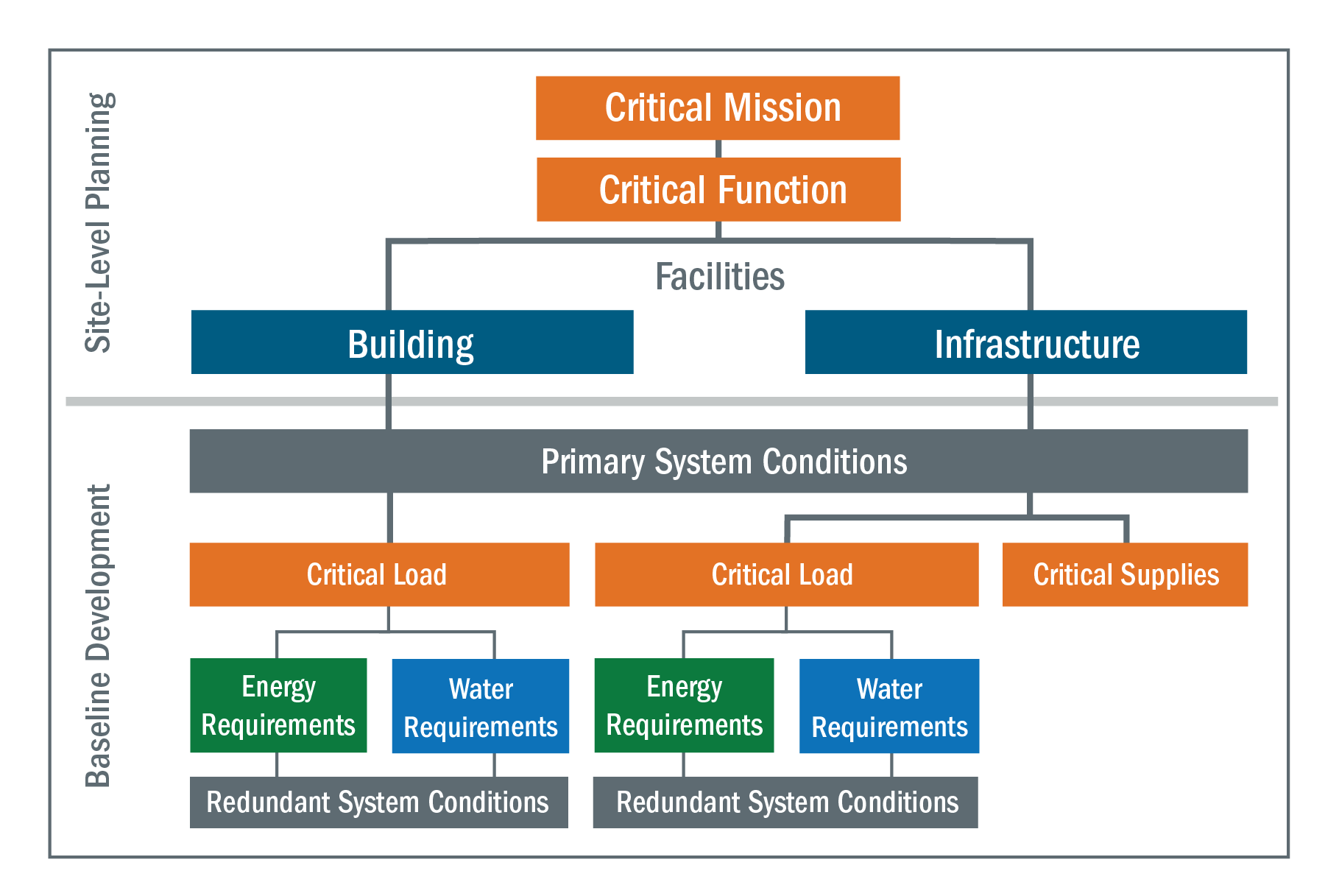Inputs Needed
- Critical functions and associated facilities list from Site-Level Planning: Action 4
- Facility energy and water use data from Baseline Development: Action 1
- List of mission owner representatives familiar with facility operations to interview from Site-Level Planning: Action 1
Outputs
- Validated list of facilities supporting critical functions
- Critical loads identified
- Critical load tolerable outage duration
- Critical load daily energy and water use for Baseline Development: Action 3 and Solution Development: Action 2
Overview
In this action, the resilience planning team seeks to understand how the facilities that perform critical functions rely upon energy and water. Facilities will have multiple energy and water loads, yet not all will be critical. The resilience planning team collects data primarily through interviews with mission owners and site operators to establish the specific systems required to sustain critical functions and what the energy and water requirements of those systems are. These are referred to as the critical loads. Additionally, the team identifies how long a critical load could be lost without unacceptable interruption to the supported critical function.
In-Depth
Critical energy and water requirements refer to the amount of energy or water needed over a day to support a critical load. The resilience planning team gathers data on critical energy and water requirements through interviews with mission owners and site operators and review of energy and water use documentation identified in Baseline Development Action 1: Collect and Review Baseline Documentation.
Consider questions such as:
- For each facility supporting a critical function, which systems require reliable access to energy and/or water?
- Would the loss of energy and/or water to support these functions lead to mission failure or mission degradation?
- How long can the critical load be without power and/or water until the mission has failed or degraded? How long must the critical load run to meet mission requirements?
- How much energy and/or water is required to sustain the critical loads?
- When measured energy and water use data is not available, can information about operation of the facility (e.g., occupancy hours, functions housed) be used to estimate energy and water requirements?

The TRN Resource: Interview Questions can be used to facilitate discussions with mission owners and site operations personnel and document findings. These questions are used to establish the critical energy and water requirements in this action, as well as the baseline conditions of energy and water redundant systems in Action 3. Many of the questions posed are required inputs to the Risk Assessment module. Data collection for each of these actions is combined here to allow for a single meeting with each mission owner representative. The resilience planning team should identify representatives who are knowledgeable about the critical functions, the operating conditions of the buildings, and any existing redundant energy and water systems on those facilities, which could include a mission leader and a building engineer. For large sites with multiple missions and numerous facilities, the resilience planning team may hold dozens of interviews to establish the critical energy and water requirements.
Determine Tolerable Outage Duration
A key activity within the interviews is to review each critical load and determine the tolerable outage duration (TOD) of the load. Determine the TOD of critical loads by evaluating how long a critical load could be lost (i.e., without energy or water supplies) without unacceptable interruption to the supported critical function. Record this information in the worksheet for this action.
Estimate Critical Load Energy and Water Requirements
Once the critical loads are identified, the resilience planning team estimates the energy and water required to support those loads. This information is needed to determine if any existing redundant systems are designed to meet the requirements and that any new systems proposed are properly designed. The TRN Resource: Energy and Water Daily Use Estimation Approaches provides information on different approaches to determining the energy and water requirements for each critical load. The worksheet for this action can be used to document the site critical loads for use in the Risk Assessment module.
To establish energy or water use, the resilience planning team should gather or estimate energy and water use data over a one-year period at a minimum and include periods of peak operations when energy or water demands may have been higher. The daily average and peak load profiles should be quantified, showing how much energy or water is used on average in a day and the maximum loads that a redundant system would need to support. Ideally, energy and water use estimates would be established for all critical loads within the facility; however, facilities are not always configured to enable redundant systems to solely support critical loads. In these cases, the full facility load may be used. Building and system-level metered energy and water data is the preferred data source. When such data is not available, estimation approaches can be used, as indicated in the TRN Resource: Energy and Water Daily Use Estimation Approaches.
